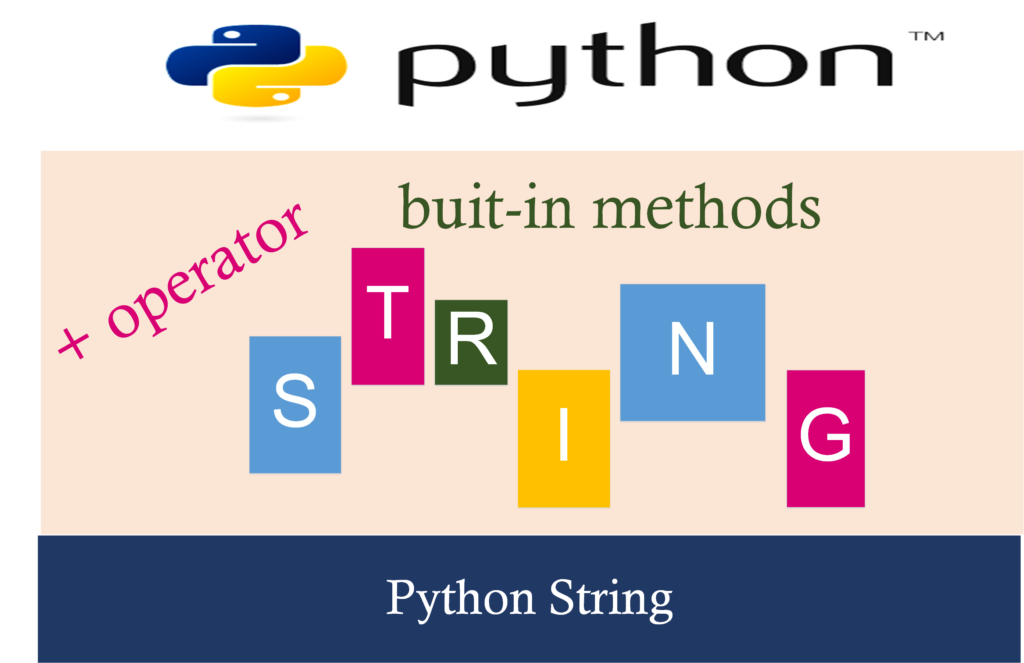After reading this Python String topic, you will understand how to write and manipulate the string, and you will understand how to + operator for string use in Python.

A group of characters is known as string. Characters that can be used in string as lowercase letters (a – z), uppercase letters (A – Z), digits (0 – 9) and other characters as (#, %, &, etc.).
How to write string in python?
A string writes inside a pair of single quotation mark or a string can also write inside a pair of a double quotation mark.
Example:
Program (1): To demonstrate how to write and display string in Python.
# string write inside a pair of single quotation mark x='programming' print(x) # string write inside a pair of double quotation mark y="programming" print(y)
Output(1)
programming programming
Explanation: for Program(1) and Output(1)
- statement x=’programming’ gives output as programming.
- statement y=”programming” gives output as programming.
- So, the string writes inside a pair of single or double quotation mark gives the same output.
Accessing Character from String
Example:
Program (1): To demonstrate how to access character from string in Python.
# string write inside a pair of single quotation mark x='programming' print(x[0]) print(x[1])
Output(1)
p r
Explanation: for Program(1) and Output(1)
- statement print(x[0]) gives output p describe the first character of string (i.e. programming) is associated with index number 0.
- statement print(x[1]) gives output r describe the second character of string (i.e. programming) is associated with index number 1.
Accessing Multiple Character from String
Example:
Program (1): To demonstrate how to access multiple characters from the string in Python.
# string write inside a pair of single quotation mark x='programming' print(x[1:4])
Output(1)
rog
Explanation: for Program(1) and Output(1)
- statement print(x[1:4]) gives output rog describe accessing characters of the string associated with index numbers 1 to 3.
+ operator for Strings
The + operator use for two or more strings concatenation.
Example:
Program (1): To demonstrate how to concatenate any two string in Python.
y='python ' x='programming' print(y+x)
Output(1)
python programming
Explanation: for Program(1) and Output(1)
- variable y stores string as python.
- variable x stores string as programming.
- statement print(y+x) represents a string of variable y concatenate with a string of variable x and hence the output is python programming.
String handling built-in Methods
Some of the commonly used string handling methods like len(), lower() and upper().
len(): This method calculates and gives the length of the string.
Example:
Program (1): To demonstrate how to use len() function in Python.
x='programming' print(len(x))
Output(1)
11
Explanation: for Program(1) and Output(1)
- The length of string ‘programming’ is 11.
lower() : This method convert complete string into lowercase string.
Example:
Program (1): To demonstrate how to use lower() function in Python.
x='PYTHON' print(x.lower())
Output(1)
python
Explanation: for Program(1) and Output(1)
- The variable x stores the string ‘PYTHON’.
- statement print(x.lower()), print and convert string ‘PYTHON’ into the lowercase string as python.
upper(): This method converts the complete string into the uppercase string.
Program (1): To demonstrate how to use upper() function in Python.
x='python' print(x.upper())
Output(1)
PYTHON
Explanation: for Program(1) and Output(1)
- The variable x stores the string ‘python’.
- statement print(x.upper()), print and convert string ‘python’ into the uppercase string as PYTHON.